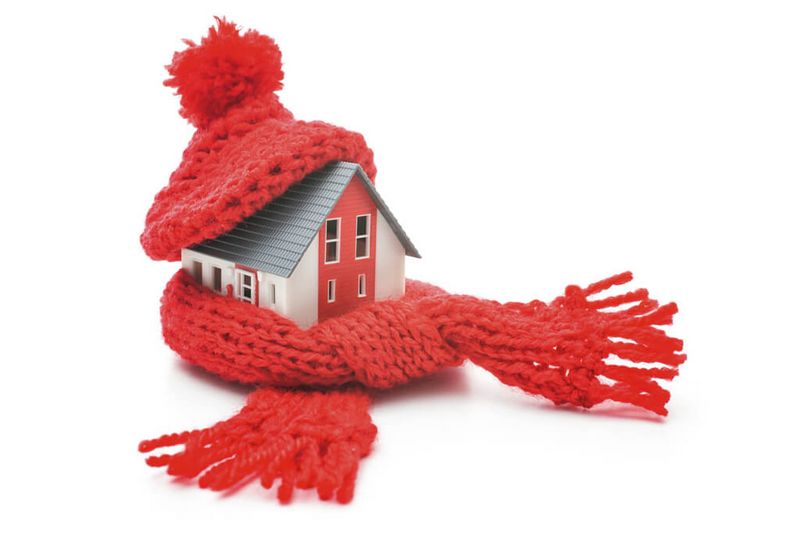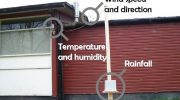
How to Keep Your Home Warm When It’s Chilly Outside
As the temperature drops and winter approaches, it’s important to find ways to keep your home warm and cozy. Whether you live in a cold climate or just experience chilly weather from time to time, there are several simple tips you can follow to ensure that your home stays warm and comfortable.
One of the first things you can do is to properly insulate your home. This can help retain heat and prevent drafts, keeping the cold air out and the warm air in. Insulating your walls, windows, and doors can make a big difference in maintaining a comfortable temperature inside.
Another tip is to use window coverings effectively. Thick curtains or blinds can help keep the cold air out and prevent heat from escaping. Opening your curtains during the day to let in natural sunlight can also help warm up your home, while closing them at night can provide an additional layer of insulation.
Using a programmable thermostat is another great way to keep your home warm. By setting a schedule for your heating system, you can ensure that it only turns on when it’s needed, saving energy and money. Lowering the temperature slightly at night or when you’re not at home can also help reduce heating costs.
Adding rugs and carpets to your floors can also help keep your home warm. Not only do they add a cozy feel to a room, but they also provide additional insulation. Hardwood floors can be particularly chilly during the winter months, so adding a rug can make a significant difference.
Sealing any gaps or cracks around windows, doors, and other openings can also help prevent drafts and keep your home warm. Using weatherstripping or caulk to seal these areas can make your home more energy-efficient and reduce heat loss.
Lastly, don’t forget to maintain your heating system. Regularly cleaning or replacing your furnace filters can improve airflow and increase the efficiency of your system. It’s also a good idea to have your heating system inspected and serviced by a professional to ensure it’s working properly and efficiently.
Remember, keeping your home warm when it’s chilly outside doesn’t have to be difficult or expensive. By following these simple tips, you can create a cozy and comfortable environment that will keep you warm all winter long.
Insulate Your Windows to Prevent Heat Loss
One of the key ways to keep your home warm during chilly weather is to insulate your windows. Windows are a common source of heat loss in homes, as they can allow cold air to seep in and warm air to escape.
Here are some tips on how to insulate your windows and prevent heat loss:
- Weatherstripping: Apply weatherstripping around the edges of your windows to seal any gaps and prevent drafts. Weatherstripping can be easily applied with adhesive backing.
- Window film: Install window film to create an extra layer of insulation. This film is transparent and can be easily applied to the inside of your windows. It helps to keep warm air inside and cold air outside.
- Window coverings: Hang thick curtains or blinds over your windows to help insulate them. You can also consider adding a thermal lining to your curtains for extra insulation.
- Draft stoppers: Use draft stoppers or door sweeps to seal any gaps at the bottom of your windows. These can be easily installed and help to keep cold air from entering your home.
In addition to these tips, it’s also important to check for any cracks or gaps around your windows and seal them with caulk or sealant. This will further help to prevent heat loss and keep your home warm.
By taking these steps to insulate your windows, you can significantly reduce heat loss and keep your home cozy and warm even when it’s chilly outside.
Use Thick Curtains or Blinds to Keep Out Drafts
When it’s chilly outside, one of the easiest and most cost-effective ways to keep your home warm is to use thick curtains or blinds. These window coverings can help to insulate your windows and prevent cold drafts from seeping into your home.
Thick curtains are especially effective at keeping out drafts because they act as a barrier between the cold air outside and the warm air inside. Look for curtains that are made from heavy materials like thermal or blackout fabric, as these are designed to provide maximum insulation.
When choosing blinds, opt for ones made from thicker materials, such as wood or fabric. These types of blinds will create a thicker barrier and help to keep your home warm.
It’s also important to ensure that your curtains or blinds are properly fitted to your windows. Make sure they cover the entire window frame and fit snugly against the walls to prevent any gaps where cold air can seep in.
During the day, open your curtains or blinds to allow natural sunlight to warm up your home. But as soon as it starts getting dark or the temperature drops, close them to trap the warmth inside.
Using thick curtains or blinds to keep out drafts is an effective and simple way to keep your home warm when it’s chilly outside. By using these window coverings properly, you can create a cozy and comfortable environment to enjoy during the colder months.
Seal Cracks and Gaps in Your Home’s Foundation
One of the most effective ways to keep your home warm when it’s chilly outside is to seal cracks and gaps in your home’s foundation. These openings can allow cold air to enter your home and warm air to escape, making it harder to maintain a comfortable temperature.
To keep your home warm, start by inspecting the foundation for any visible cracks or gaps. These can often be found around windows, doors, and utility penetrations. Use a flashlight to help you see in dark areas.
Once you’ve identified the cracks and gaps, use a suitable sealant to fill them in. There are various sealants available on the market, including caulk and foam sealants. Choose one that is appropriate for the size and type of gap or crack you’re sealing.
Before applying the sealant, clean the area thoroughly to remove any dirt, dust, or debris. This will ensure better adhesion and a more effective seal. Use a brush or vacuum to clean the area, and wipe it down with a damp cloth to remove any remaining residue.
Apply the sealant according to the manufacturer’s instructions. This may involve using a caulk gun or simply squeezing the sealant from a tube. Ensure that the sealant completely fills the crack or gap, and smooth it out with a putty knife or your finger. You may need to apply multiple layers for larger gaps.
After applying the sealant, allow it to fully dry and cure before testing for any remaining drafts. This may take several hours or even a few days, depending on the type of sealant used. Once the sealant is dry, use your hand to feel for any remaining cold air leaks.
In addition to sealing cracks and gaps in your home’s foundation, it’s also important to insulate any exposed pipes or ductwork in the basement or crawl space. Cold air can easily enter through these areas, so insulating them will help keep your home warm.
In conclusion, sealing cracks and gaps in your home’s foundation is a crucial step in keeping your home warm when it’s chilly outside. By taking the time to inspect for and seal these openings, you can significantly improve the insulation and overall comfort of your home.
Add Weather Stripping to Doors and Windows
One of the most effective ways to keep your home warm when it’s chilly outside is to add weather stripping to your doors and windows. Weather stripping is a material that is applied to the edges of doors and windows to seal any gaps and prevent cold air from entering and warm air from escaping.
There are several types of weather stripping available, including adhesive-backed foam tape, V-strip, and door sweeps. Adhesive-backed foam tape is the most common option and is easy to install. Simply measure the length of each door and window frame and cut the foam tape to fit. Peel off the backing and press the tape firmly in place to create a tight seal.
V-strip weather stripping is another popular choice. It is made of metal or plastic and can be used on both doors and windows. To install V-strip weather stripping, simply measure the length of the door or window and cut the strip to fit. Then, press the strip into the groove or channel along the edge of the door or window to create a barrier against drafts.
Door sweeps are another effective option for sealing gaps underneath doors. They are typically made of a flexible material, such as rubber or vinyl, and attach to the bottom of the door. Door sweeps create a tight seal when the door is closed, preventing cold air from entering and warm air from escaping.
When adding weather stripping to your doors and windows, it’s important to ensure a proper fit. Carefully measure the length of each frame and cut the weather stripping to fit. Make sure to clean the surface before applying the weather stripping to ensure a strong bond. Additionally, check the weather stripping regularly to ensure it is still in good condition and replace it if necessary.
- Measure the length of each door and window frame
- Cut the weather stripping to fit
- Clean the surface before applying
- Check and replace weather stripping regularly
By adding weather stripping to your doors and windows, you can significantly increase the insulation of your home and keep it warm during chilly weather. This simple and affordable solution can help you save on heating costs and create a more comfortable living environment.
Install a Programmable Thermostat for Efficient Heating
If you want to keep your home warm when it’s chilly outside, one of the best ways to do so is by installing a programmable thermostat. With a programmable thermostat, you have more control over the temperature in your home, allowing you to set specific times for your heating system to turn on and off.
By setting your thermostat to a lower temperature when you’re away from home or asleep, you can save energy and reduce your heating bills. Then, you can program your thermostat to increase the temperature when you’re at home and need it to be warm.
A programmable thermostat also offers the convenience of being able to adjust the temperature remotely. Many of these thermostats can be controlled using a smartphone app, so you can easily make changes to the temperature even if you’re not at home.
Additionally, programmable thermostats often come with energy-saving features, such as adaptive recovery, which allows the thermostat to learn how long it takes to heat your home and adjust the temperature accordingly. This can help to ensure that your home is always at the desired temperature without wasting energy.
If you’re serious about keeping your home warm and reducing your heating costs, investing in a programmable thermostat is a smart choice. It’s a simple and effective way to maintain a comfortable temperature in your home while being more energy-efficient.
Use Door Draft Stoppers to Keep Cold Air Out
When it’s chilly outside, the last thing you want is cold air seeping into your warm home. One way to prevent this is by using door draft stoppers. These handy devices are designed to block cold air from entering your home through the gap under your doors.
Here’s how to use door draft stoppers to keep your home warm:
- Measure the Gap: Start by measuring the gap under your door. This will help you determine the right size door draft stopper to purchase.
- Choose the Right Type: There are different types of door draft stoppers available, such as foam, fabric, or rubber. Choose the one that best suits your needs.
- Install the Door Draft Stopper: Once you have selected your door draft stopper, it’s time to install it. There are several ways to do this, depending on the type you have chosen. Some door draft stoppers can be simply placed on the floor, while others need to be attached to the door itself.
- Ensure a Proper Seal: To effectively keep cold air out, it’s important to ensure a proper seal. Make sure the door draft stopper is snug against the bottom of the door and fills the entire gap.
- Replace Old or Damaged Door Draft Stoppers: Over time, door draft stoppers can wear out or become damaged. If you notice cold air coming in despite having a door draft stopper, it may be time to replace it.
- Use Double Draft Stoppers for Extra Insulation: If you want an extra layer of insulation, consider using double draft stoppers. These are designed to seal both sides of the door, providing even greater protection against cold air.
- Keep Doors Closed When Not in Use: In addition to using door draft stoppers, keeping doors closed when not in use can also help keep cold air out and maintain a warm home.
By using door draft stoppers, you can effectively keep cold air out and maintain a warm and cozy home, even when it’s chilly outside.
Place Rugs or Carpets on Cold Floors for Insulation
When it’s chilly outside, one of the easiest ways to keep your home warm is to place rugs or carpets on cold floors. Cold floors can make a room feel uncomfortable and can also cause your heat to escape, making it harder to keep your home warm. By adding rugs or carpets to your floors, you can create a layer of insulation that will help to trap the heat inside your home.
By placing rugs or carpets on your floors, you can help to prevent drafts from coming in through the floorboards and reduce heat loss. Rugs and carpets act as a barrier between the cold floor and your feet, providing an extra layer of insulation to keep your home cozy.
Choose rugs or carpets that are thick and plush for maximum insulation. Look for materials like wool or natural fibers, as they have excellent insulating properties. You can also use rug pads or carpet underlayments to further enhance the insulation of your floors.
In addition to keeping your home warm, rugs and carpets can also add style and comfort to your living space. They come in a variety of colors, patterns, and textures, allowing you to choose a design that suits your personal taste and complements your decor.
Remember to regularly clean and maintain your rugs and carpets to keep them in good condition and ensure they continue to provide insulation. Vacuum them regularly to remove dust and dirt, and consider professional cleaning services for a deep clean.
So, if you want to keep your home warm when it’s chilly outside, don’t forget to place rugs or carpets on your cold floors. They will not only provide insulation but also add comfort and style to your living space.
Use Draft Excluders at the Bottom of Doors
One of the most common areas where cold air can enter your home is through the gaps at the bottom of doors. To keep your home warm when it’s chilly outside, it’s important to block these drafts. One effective way to do this is by using draft excluders. These simple tools are designed to fit underneath the door and seal the gap, preventing cold air from entering and warm air from escaping.
Here are a few tips on how to use draft excluders:
- Measure the width of your door: Before purchasing a draft excluder, measure the width of your door to ensure you choose the correct size.
- Choose the right type of draft excluder: There are various types of draft excluders available, such as brush strips, foam strips, or rubber seals. Choose the type that best suits your needs and budget.
- Clean the door bottom: Before installing the draft excluder, make sure the bottom of the door is clean and free from any dirt or debris. This will ensure a proper seal.
- Attach the draft excluder: Place the draft excluder at the bottom of the door, making sure it aligns with the width of the door. Some draft excluders come with adhesive strips, while others may require screws or nails for installation. Follow the manufacturer’s instructions for proper installation.
- Check for gaps: After installing the draft excluder, close the door and check for any remaining gaps. If you notice any leaks, adjust the draft excluder to ensure a tight seal.
- Consider installing draft excluders on other doors: Don’t forget to install draft excluders on other doors in your home, such as exterior doors, garage doors, or doors leading to unheated areas.
- Regularly maintain and replace draft excluders: Over time, draft excluders may wear out or get damaged. Check them regularly and replace them as needed to ensure optimal performance.
By using draft excluders at the bottom of doors, you can significantly reduce drafts and keep your home warmer when it’s chilly outside. This simple and affordable solution can make a big difference in improving the energy efficiency of your home and reducing heating costs.
Close Off Unused Rooms to Prevent Heat Loss
When the temperature drops outside and it’s chilly in your home, it’s important to take steps to keep it warm. One simple but effective strategy is to close off unused rooms to prevent heat loss. By doing this, you can concentrate the heat in the rooms you use most often, making them more comfortable and reducing energy waste.
To close off unused rooms, start by shutting the doors and sealing any gaps or cracks around them. This will prevent cold air from seeping in and warm air from escaping. You can use weatherstripping or caulk to seal the gaps. Additionally, consider placing draft stoppers at the bottom of the doors to further minimize heat loss.
Another method to close off rooms is to use plastic sheeting or thermal curtains on the windows and doors in those areas. These materials provide an extra layer of insulation and can help trap heat inside the rooms. Thermal curtains, in particular, are designed to block drafts and can greatly improve the energy efficiency of your home.
If you have central heating, you can also adjust the vents to redirect the warm air to the rooms you’re actively using. Simply close the vents in the unused rooms and open them in the rooms you want to keep warm. This way, you can customize the heating distribution based on your preferences and needs.
Closing off unused rooms not only helps keep your home warm but can also save you money on heating costs. By reducing the space you’re heating, you’ll consume less energy and spend less on heating bills. Additionally, it’s a simple and low-cost solution that anyone can implement.
So, when it’s chilly outside, take the time to close off any unused rooms in your home. By preventing heat loss, you can create a more comfortable and energy-efficient living environment.
Use a Hot Water Bottle or Heating Pad to Warm Your Bed
When it’s chilly outside, one of the best ways to keep your home warm is to make sure your bed is cozy and inviting. One simple and effective way to do this is by using a hot water bottle or a heating pad to warm up your bed before you climb in.
Here are a few tips on how to use a hot water bottle or heating pad to warm your bed:
- Fill a hot water bottle with hot water or plug in a heating pad and let it warm up.
- Place the hot water bottle or heating pad at the foot of your bed before you go to sleep.
- Wrap the hot water bottle or heating pad in a towel to prevent burns or discomfort.
- Leave the hot water bottle or heating pad in your bed for a few minutes to warm up the sheets and blankets.
- Remove the hot water bottle or heating pad before you get into bed to ensure your bed is at a comfortable temperature.
- Climb into your warm and cozy bed and enjoy a restful night’s sleep.
Using a hot water bottle or heating pad to warm your bed is a simple and affordable solution to keep your home warm during chilly nights. Give it a try and experience the comfort and warmth it can bring to your sleep environment.
Keep Windows Closed at Night to Trap Heat
When it’s chilly outside, one of the key strategies to keep your home warm is to keep the windows closed at night. While it may be tempting to crack open a window for fresh air, this can let cold drafts into your home and allow the warm air to escape. By keeping your windows closed, you can trap the heat inside your home and make it more comfortable.
If you need to ventilate your home, consider using extractor fans or opening the windows during the day when it’s warmer outside. This way, you can still get fresh air without letting the cold air in.
Hang Thermal Curtains to Retain Heat
One of the most effective ways to keep your home warm when it’s chilly outside is to hang thermal curtains. These specially designed curtains are made from thick, insulating materials that help to trap heat inside your home, preventing it from escaping through your windows.
Thermal curtains work by creating a barrier between the cold air outside and the warm air inside. The thick layers of fabric help to block drafts and keep your home cozy and comfortable. They are especially beneficial for older homes that may have drafty windows.
To maximize the benefits of thermal curtains, it’s important to choose the right size and install them properly. Measure your windows carefully and choose curtains that are slightly wider and longer than the window frame to ensure maximum coverage. Install curtain rods or tracks securely to support the weight of the thermal curtains.
When hanging thermal curtains, it’s also important to make sure they are properly sealed. Use curtain hooks or clips to secure the curtains tightly against the wall to prevent any air leakage. You can also consider adding a pelmet or valance above the curtain rod to further enhance insulation.
In addition to improving insulation, thermal curtains also provide other benefits. They can help to reduce outside noise, block out light, and protect your privacy. These curtains are available in a variety of styles and colors, so you can easily find options that match your home’s decor.
- Choose thermal curtains made from thick, insulating materials
- Measure your windows carefully to ensure the right size
- Install curtain rods or tracks securely
- Seal the curtains tightly to prevent air leakage
- Consider adding a pelmet or valance for extra insulation
By hanging thermal curtains in your home, you can effectively retain heat and keep your living space warm and cozy, even when it’s chilly outside. Plus, you’ll enjoy the added benefits of noise reduction, light blocking, and privacy protection.
Use Reflective Foil Behind Radiators to Maximize Heat Output
When it’s chilly outside, one of the best ways to keep your home warm is by optimizing the heat output from your radiators. One simple and effective method is to use reflective foil behind your radiators.
Reflective foil acts as a barrier, preventing heat from being absorbed into the wall and instead reflecting it back into the room. This means that more heat is directed into your home, making it warmer and more comfortable.
To install reflective foil behind your radiators, follow these steps:
- Clean the wall behind the radiator to ensure proper adhesion of the foil.
- Cut the foil to the appropriate size, leaving a few inches around the edges for easy installation.
- Apply adhesive to the back of the foil, ensuring it is evenly distributed.
- Press the foil firmly onto the wall, starting from the top and working your way down.
- Smooth out any air bubbles or wrinkles using a roller or your hands.
- Trim off any excess foil around the edges for a neat and tidy finish.
- Repeat the process for each radiator in your home, ensuring that the foil is installed securely and snugly behind each one.
By using reflective foil behind your radiators, you can maximize the heat output and keep your home warm and cozy even during the coldest months of the year. It’s a simple yet effective solution that can make a big difference in maintaining a comfortable indoor temperature.
Question-answer:
Why is it important to keep my home warm when it’s chilly outside?
Keeping your home warm is important for several reasons. Firstly, it helps to maintain a comfortable living environment during the colder months. Secondly, it can help prevent health issues such as colds, flu, and respiratory problems. Lastly, keeping your home warm also helps to protect your property from the potential damages caused by extreme cold.
What are some practical ways to keep my home warm?
There are several practical ways to keep your home warm when it’s chilly outside. You can start by insulating your windows and doors with weatherstripping or draft stoppers to prevent cold air from entering. Additionally, you can use caulk or sealant to fill in any gaps or cracks in your walls or floors. Another effective method is to use heavy curtains or thermal blinds to trap heat inside your rooms.
How can I improve the heating efficiency of my home?
To improve the heating efficiency of your home, you can start by checking your heating system. Make sure that it is well-maintained and in good working condition. You can also consider adding insulation to your walls, attic, and crawl spaces to minimize heat loss. Additionally, using a programmable thermostat can help you regulate the temperature more efficiently by adjusting it according to your schedule.
Are there any alternative methods to keep my home warm?
Yes, there are several alternative methods to keep your home warm when it’s chilly outside. One option is to use portable space heaters in specific areas that you frequent, rather than heating the entire house. You can also use electric blankets or heated mattress pads to stay warm during the night. Another alternative method is to use radiant floor heating, which provides a comfortable and efficient way to heat your home.







